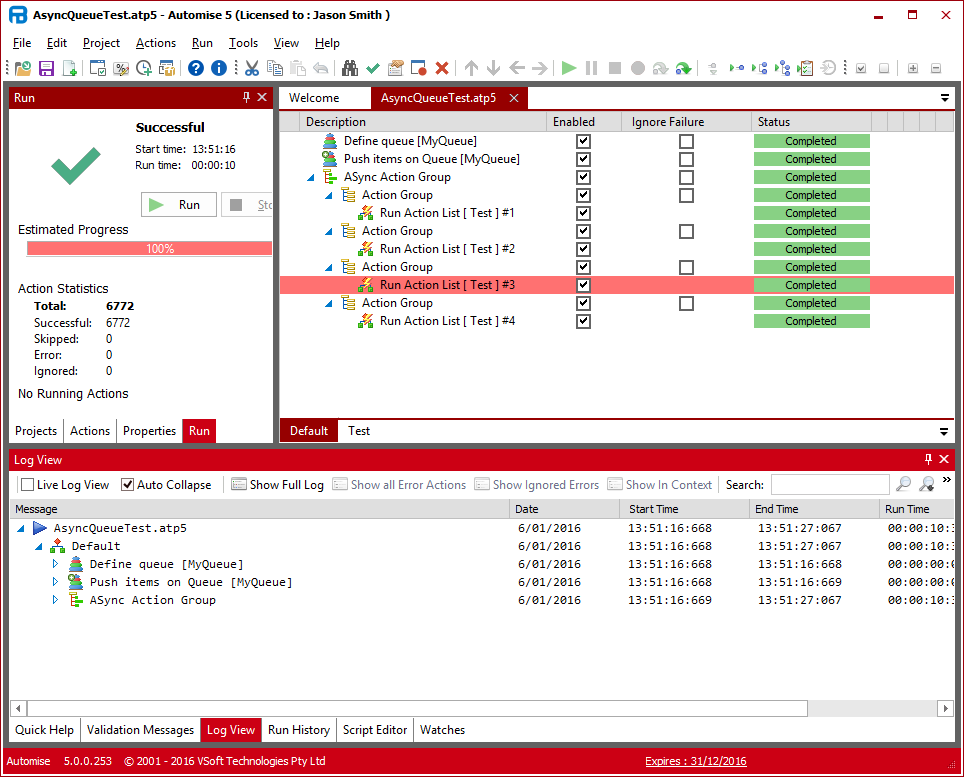What's new in Automise 5
IDE Themes
The IDE has two new themes, Dark and Light (yes, imaginatively named!). The IDE defaults to Dark on first run, however you can change the theme in the options quite easily. The themes are still a work in progress, we are waiting on an update from a third party control vendor to resolve some issues.


Debugger
One of the most asked for features now available in Automise 5, stepping into included projects. In Automise 7 and earlier, you could only step over included projects, and wait for them to return. In Automise 5, you can step into the included project, if it is not already opened the IDE will open the project and switch to it automatically. To make this possible, there are now "Step Into" and "Step Over" functions. The Step into/over now also applies to Action Lists (see below).
Debugger breakpoints now have conditions :

Run Action List Action
You can now return values from Action Lists (ie out parameters) .

Non Visible Changes
Stepping Engine
The stepping engine was rewritten to enable stepping into included projects, and to enable Action List dependencies. This, work, together with the new variables architecture is where the bulk of effort/time was spent in the Automise 5 development cycle.
Variables Architecture
The variables architecture and the expression evaluator were rewritten to resolve several corner case issues that we were not able to resolve in Automise 7. The expression evaulator has a new parser that will allow us to more easily extend the syntax in the future. The User variable namespace was removed, it caused too many problems with projects not running under other users, not running on the build server etc. Use Project variables instead.
Core Messaging
Changes to the messaging has allowed us to improve the performance of the stepping engine and logging, with much less thread switching. This also improved the IDE performance.
CLR Hosting
The minimum CLR version is now .NET 4.0 (ie Automise requires .net 4.0 to be installed).
Code Changes
In addition to the architectural changes, we also spent a lot of time refactoring the code, running static analysis tools over the source, looking for memory leaks, potential bugs etc. One of the results of this is reduced memory usage during a build compared to AT4. The AT5 IDE does use slightly more memory than the AT4 IDE at startup (mostly due to the heavy use of delphi generics), however the runtime memory usage is much lower.A large part of the refactoring involved unit testing (we created a new unit test framework to suite our needs!) and creating a suite of integration tests.
FBCmd
The command line parameters have changed to be more consistent and easier to specify. You can also specify one or more Action Lists to execute (when not specified, the default Action List is executed).
New Project File Formats
Automise has used an xml file format since version 1, however a common complaint over the years, has been that it is difficult to diff file versions. Automise 5 has tackled this in two ways.
A new DSL style project file format (.atp5) is now the default format, it is very easy to diff.
project
beginprojectid = {04710B72-066E-46E7-84C7-C04A0D8BFE18}targetbegin name = Default targetid = {E6DE94D6-5484-45E9-965A-DB69885AA5E2} rootaction begin action.group begin id = {D860420B-DE46-4806-959F-8A92A0C86429} end endend
end
A new xml format (.atx5), much less verbose than the old format.
<?xml version="1.0" encoding="UTF-8"?>
<Automise><project> <projectid>{6A717C24-D00F-4983-9FD0-148B2C609634}</projectid> <target> <name>Default</name> <targetid>{E6DE94D6-5484-45E9-965A-DB69885AA5E2}</targetid> <rootaction> <action.group> <id>{D860420B-DE46-4806-959F-8A92A0C86429}</id> </action.group> </rootaction> </target></project>
</Automise>
Compressed project files (.atz5) use the dsl format internally (compressed projects are just a zip file with a project.atp5 inside it).
The default project file encoding is now UTF-8, which is more version control friendly (some version control systems treat utf-16 as binaries),